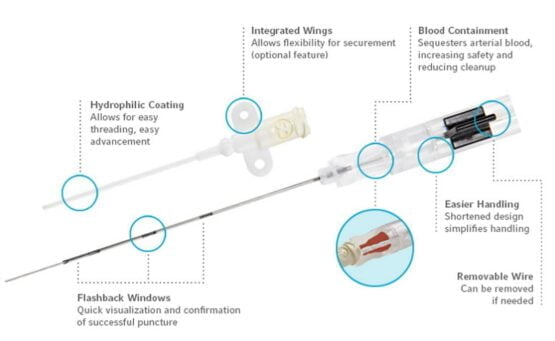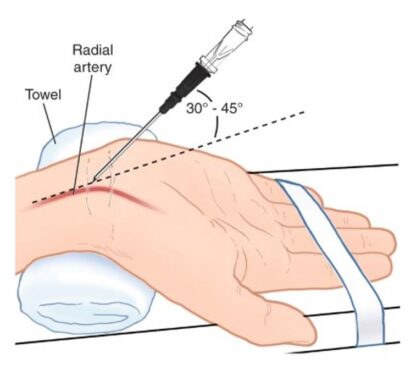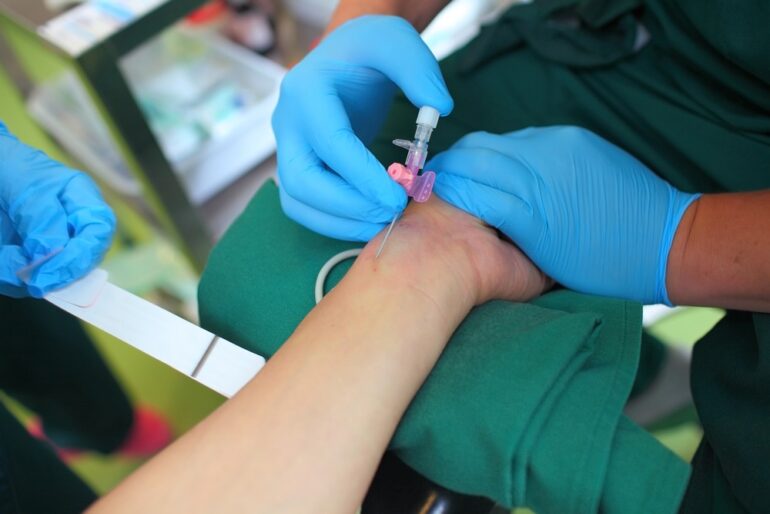Blood pressure quantification is one of the fundamental practices while dealing with a patient as the fluctuations in the BP are the basic variables for the assessment of cardiovascular health. Usually, a BP apparatus is employed to serve the purpose which is a method, although widely accepted and frequently applied, with certain inadequacies due to lower sensitivity as well as accuracy. However, for the accurate determination of blood pressure, it is evident that more sensitive devices, unlike blood pressure cuffs, are needed. In this domain, one of the best devices is the arterial catheter.
What is an arterial catheter?
An arterial catheter or, as it is frequently called, an art line is a slender tube with a hollow bore that is intended to be inserted into an artery at certain locations in the body with the aim to measure the pressure of blood.

Parts of an arterial catheter
When is an arterial catheter needed?
If a patient has one of the following conditions, there is a need to employ an arterial catheter:
- Hypotension or low blood pressure: In case of severely low blood pressure, a patient needs to be treated with certain medications which help in increasing the blood pressure until it approaches the normal value. For this purpose, the physician must know the existing blood pressure accurately so that the most suitable dose of the drug could be calculated. Moreover, once the drug is administered via the IV route, the second-to-second monitoring of the blood pressure is necessary to have an estimation of how well the body is responding to the given drug.

Blood pressure is being measured using an arterial catheter
- Hypertension or high blood pressure: The same goes for hypertensive patients with the difference in that in this situation, the blood pressure is needed to be reduced instead of elevating it. Suitable medications are administered to the patient and constant monitoring using an arterial catheter assists in rendering the physician aware of the blood pressure changes.
- Respiratory issues: In some patients, it is necessary to frequently quantify the blood level of oxygen or carbon dioxide which may vary due to ongoing lung disease. The physician takes a blood sample 3 to 4 times a day to estimate the level of oxygen in the blood as well as to adjust it accordingly. For this purpose, an arterial catheter can be used. It can be placed within the artery once and multiple samples can be drawn from it. This eliminates the need to enter a needle into the patient’s arteries 3 or 4 times a day.
The 5-step approach for inserting an arterial catheter
The following 5-step approach should be taken into consideration before arterial catheterization:
- Choose the suitable location: A suitable artery should be chosen where the arterial catheter is to be inserted. These include many arteries in the wrist, groin, or other regions which are enlisted below:
- Radial artery (Most commonly used route)
- Brachial artery
- Femoral artery
- Ulnar artery
- Axillary artery
- Temporal artery
- Choose the suitable type of arterial catheter: Choosing the suitable arterial catheter with the appropriate length is dependent upon the artery where it is to be inserted. A longer catheter should be preferred for the brachial, axillary, or femoral artery owing to the long distance between the lumen and the skin surface. However, more complications are associated with the longer catheters as compared to the shorter ones.
- Insert the catheter at the selected location: Next step is the proper placement of the catheter into the artery which needs to be done under sterile conditions. The catheterization kit includes iodine or chlorhexidine solution along with 1% lidocaine solution which acts as a local anesthetic. Additionally, adhesive tape to secure the catheter after insertion, nylon suture, needle driver, and catheter-over-the-needle are also included. To place the arterial catheter properly, the following steps must be followed:
- The patient’s wrist is stretched and the radial artery is located.
- The skin is rubbed with the antiseptic solution and a local anesthetic is applied.
- With the help of catheter-over-the-wire, an arterial catheter is inserted at a 45-degree angle using one of the following approaches:

An arterial catheter is inserted into the radial artery
- Seldinger technique
- Integral guide wire approach
- Direct puncture
- Ultrasound-guided approach
- Once inside the artery, the guide wire is removed.
- Leveling and zeroing of the pressure transducer: For the purpose of taking accurate blood pressure values, the pressure transducer attached to the arterial catheter must be leveled up and zeroed before starting to take the measurements.
- Monitor the BP qualitatively: Once the arterial catheter is placed properly, the BP is monitored to ensure the proper functioning of the catheter.
Risks associated with the use of an arterial catheter
As the arterial catheter is to be inserted into the blood vessels, it can create some issues which, if severe, can be highly troublesome in some cases:
- Infections: The arterial catheters have a tendency to transmit infections into the bloodstream. Care should be taken with frequent replacement of the tubing as well as cleaning of the area to minimize the chances of infections.
- Pain and discomfort: The patient can experience pain while the arterial catheter is being inserted. Local anesthetics can be used to solve this issue.
- Bleeding: Insertion of an arterial catheter can start the bleeding. Usually, it stops after a while without needing any special care. If not, the catheter should be removed and pressure should be applied.
- Thrombosis: Sometimes, while insertion, a blood clot can be formed at the tip of the arterial catheter which can get transferred into the artery and block the blood flow. To minimize the chances of clotting, the physician should keep monitoring the flow of blood through the arteries to make sure there is no hindrance.
Conclusion
For the accurate estimation of blood pressure, multiple methods are available apart from the commonly used BP apparatus. An arterial catheter is one of these devices which are employed in the arterial system to quantify the fluctuations in the BP. Moreover, these are also useful for taking multiple blood samples from a patient. Hence, arterial catheters or art lines are the ‘devices of choice’ for accurate BP determination.

PhD Scholar (Pharmaceutics), MPhil (Pharmaceutics), Pharm D, B. Sc.
Uzma Zafar is a dedicated and highly motivated pharmaceutical professional currently pursuing her PhD in Pharmaceutics at the Punjab University College of Pharmacy, University of the Punjab. With a comprehensive academic and research background, Uzma has consistently excelled in her studies, securing first division throughout her educational journey.
Uzma’s passion for the pharmaceutical field is evident from her active engagement during her Doctor of Pharmacy (Pharm.D) program, where she not only mastered industrial techniques and clinical case studies but also delved into marketing strategies and management skills.
Throughout her career, Uzma has actively contributed to the pharmaceutical sciences, with specific research on suspension formulation and Hepatitis C risk factors and side effects. Additionally, Uzma has lent her expertise to review and fact-check articles for the Health Supply 770 blog, ensuring the accuracy and reliability of the information presented.
As she continues her PhD, expected to complete in 2025, Uzma is eager to contribute further to the field by combining her deep knowledge of pharmaceutics with real-world applications to meet global professional standards and challenges.








